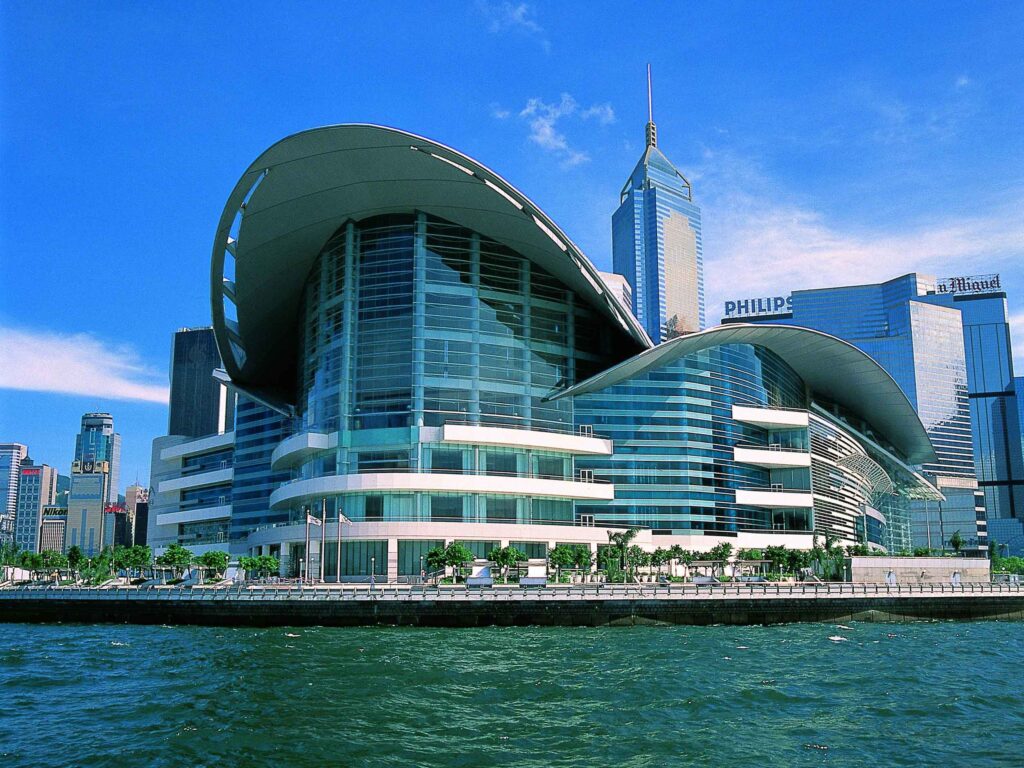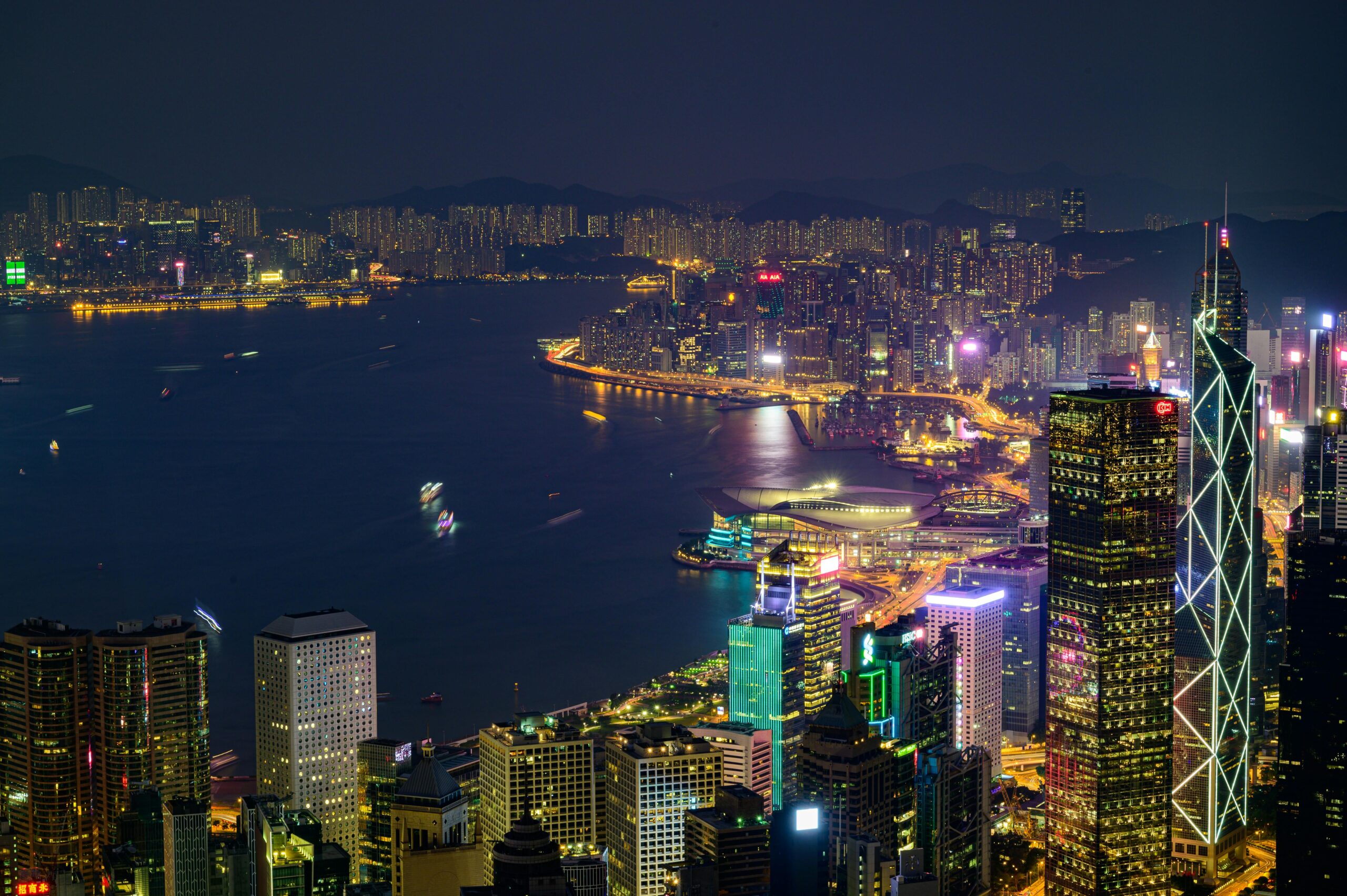One of the founding rules of commerce is to place your stall where the market can see it, where it is most likely to walk past it. Once you’ve got visibility then you can provide a product or service to satisfy – or perhaps create – a demand.
This is the story of Hong Kong’s rise as one of Asia’s preeminent exhibition destinations.
The arrival of Hong Kong on the landscape of international exhibitions can be attributed, perhaps unsurprisingly, to two major exhibitions in China. The Canton Fairs, which still exist today, were established in Guangzhou (formerly Canton) in the Guangdong Province in 1957. Taking place every spring and autumn, these huge events provided arguably the most comprehensive offering of any truly international exhibitions, and are responsible for linking a numerous and diverse group of exhibitors with a global set of buyers. The exhibitions created countless business leads, and generated some of the greatest retail business turnover in China. For many years, when China was otherwise closed, these shows provided the only window for the world to see and buy what the country was producing.
Reaching Guangdong Province from overseas required a port capable of handling vast numbers of visitors on the way in, and a vast number of products on the way out. It demanded, and still demands, straightforward and amenable import and export practice, accessibility and – equally importantly – an ability to accommodate and cater for a wide variety of international travellers.
Being home to such an influx of international visitors, it wasn’t long before visionary entrepreneurs took the liberty of tapping into the passing trade with exhibitions of their own.
Enter Hong Kong. One of two Special Administrative Regions (SARs) belonging to China, alongside its Pearl River Delta neighbour Macau, the city has seven million inhabitants, and crucially around eight per cent of these (570,000 people) hold foreign passports. Both Chinese and English are accepted as official languages here, harking back to the period of British rule from 1842 to 1997. The Canton Fairs may still have the space and the volume but, for now at least, Hong Kong has the service and the quality.
There was, in fact, some tradition of exhibitions in Hong Kong pre-dating the industry’s desire to capitalise on the Canton Fairs; exhibitions in Hong Kong go back at least to the 1930s, courtesy of the Chinese Manufacturers Association and its annual Hong Kong Product Expo, aimed largely at the general public. Events took place on various areas of open ground in Hong Kong, using temporary structures. However, in terms of the modern exhibition industry, Hong Kong became perhaps Asia’s leading exhibition hub on the back of these two events.
Hong Kong’s Trade Development Council (TDC), the leading player in the story of an emerging global exhibitions industry in the city and Asia more widely, was established in the early Seventies to promote trade. Known in Hong Kong as a statutory body, the TDC was not a government department, but was created instead by the Legislative Council on the back of an act of law. It was funded by a levy on Hong Kong exports, in effect a small tax on the value of all exports, which in the days when Hong Kong was a manufacturing hub was a significant figure. With those days now in Hong Kong’s past, exhibition activities are now the TDC’s single largest source of income.
Hong Kong’s exhibition activity really began in the Seventies, with many events taking place in the building called the World Trade Centre in Causeway Bay – then called the Hong Kong Convention Centre. A lot of the early fairs took place in the ballroom of the now-demolished Hilton Hotel, which was for many years the largest such space in Hong Kong.
The fairs began as spring and autumn fairs, selling gifts and toys, piggybacking the crowds of buyers winding their way up the Pearl River to the Canton Fairs. Between 1949 and 1979, when China was closed to the world, it was really the only way in which visitors could enter and buy Chinese-made products. And in those days the only way to get to Guangzhou was to go to Hong Kong and take the train. So the city certainly had no shortage of predictable passing trade.
In time a few private companies began to get involved and take advantage of this fact. The early Eighties saw the involvement of internationally focused companies such as AdSale, founded the previous decade by Stanley Chu to sell advertising for mainland Chinese companies looking to promote themselves to the rest of the world. This type of company was perfectly positioned to embrace and facilitate the needs of overseas companies with an eye on China.
In 1982 the Hong Kong Trade Fair was launched to sell everything from printing machinery to Jaguar cars. As the only international trade fair in Hong Kong at the time, its remit was understandably unconfined. It first took place on the roof of Ocean Terminal, the passenger terminal that sticks out into the harbour beside the Star Ferry port on the Kowloon side. The second year it was held in Kowloon Park, which had just been vacated by the British Army. Such was the profile of the event that it counted among its esteemed visitors the governor of Hong Kong; it is inconceivable that his equivalent would attend such a thing today.
While only in its second edition, the event had already demonstrated Hong Kong’s need for dedicated exhibition space.
The Hong Kong Government was in the process of turning Kowloon Park into a green lung for the city, envisioned more for morning activities, Tai Chi practitioners, lunch breaks and weekend walks rather than a commercial event on such a grand scale. It rained very heavily at this second edition of the fair and despite laying duckboards, the busy and boggy end result wasbattlefield rather less business-like than participants were hoping.
Shortly afterwards the Government approved plans to build a proper convention and exhibition centre. The TDC had been lobbying for this for a number of years, and the purpose-built facilities Hong Kong so desperately needed were on their way.
China Resources, a subsidiary of China’s specifically designated Ministry of Foreign Trade, also constructed a building titled the Hong Kong Exhibition Centre, offering just 2,500sqm of indoor space. This was quickly outgrown of course, and the exhibition area spilled into the adjoining shopping centres. Local firms were called upon to try and squeeze more floorspace out of the neighbouring areas. In one example of the desperate measures being taken, a local corporate event and management firm, Pico, was commissioned to fashion aluminium panels into an extensive ad hoc air conditioning system that extended beyond the walls of the centre into the car park of the nearby Great Eagle Centre, giving the organisers around 8,000sqm of usable space.
But the Hong Kong Exhibition Centre was destined to be a mere appetiser for the city’s growing appetite for events.
It wasn’t until 1987 that phase one of the new Hong Kong Convention and Exhibition Centre (HKCEC), a building that remains as one of Hong Kong’s most iconic landmarks, opened on the Victoria Harbour.

Building giants
The story of the development of Hong Kong’s first large exhibition centre demonstrates the way in which private enterprise can work with a government to bring benefit to a city. And the model for its creation is far removed from the model that had provided such space for cities in Germany.
In 1987, as remains the case today, there was no freehold land in Hong Kong; back then, all land was owned by the Queen of England, her counterpart today being the Hong Kong Government. The Government essentially gave the land for the development of the HKCEC to the TDC, which in turn awarded construction rights to the commercial property developer New World Development.
In simple terms, the deal enabled the TDC to develop the venue and the associated facilities surrounding it, by granting it ‘air rights’. A curious-sounding concept, but essentially any space above the 11th floor of the new venue was New World’s to do with as it wished. In addition to the funding for the convention centre, the property developer could expect to make its money from the two hotels, an office tower and an apartment building that comprised the four towers built into the first phase of the HKCEC’s development. The convention centre element belonged to the TDC.
A subsidiary of New World was then formed to manage the convention centre, the daily operation of the HKCEC. To this day it operates and collects all revenues from the exhibition and convention centre, and in return for that privilege it pays the TDC a fee from the revenue the venue makes.
In time the second phase was commissioned by the Hong Kong Government, specifically to house the handover ceremony in 1997, whereby Hong Kong was returned to China by the British. It was developed with the TDC’s input and would continue as an exhibition and convention centre after the ceremony had taken place, again owned by the TDC and managed by the HKCEC’s management firm.
This public–private collaborative model for venue development would only work in a city with a strong property market such as you have in Hong Kong, explains UFI managing director and long-time Hong Kong resident Paul Woodward, pointing out the similarity between this development and that of Hong Kong’s Mass Transit Railway (MTR). “The railway in Hong Kong is very cheap to use because the developer owns the air rights to all of the stations, which it takes advantage of by building commercial property above the MTR stations,” he observes. While the company owns and runs an underground railway, to all intents and purposes it is a massive property company.
Hong Kong, through an inventive and collaborative relationship between the public and private sectors, now had an exhibition and convention centre that would become a significant part of the city’s social and economic infrastructure.
There are few countries where private investment has built convention and exhibition centres, the majority having been developed by governments in order to incentivise trade and bring business to the cities that house them. “It’s quite a different model. It wasn’t like the exhibition industry had been conjured out of the air and nobody had ever seen one before. But it’s nothing like the tradition of the fairs that exist in Germany,” says Woodward.
At this point there were very few international players in the market. Reed was doing something, and Messe Frankfurt came in fairly early on in the late Eighties, as part of their first overseas projects. But none the less, the TDC’s exhibition portfolio quickly came to fill it up, as did others such as the Asia-Pacific Leather Fair.
However, high occupancy aside, the dominance of a single venue in a city soon becomes a point of consternation for people looking to bring global exhibitions to the market. The TDC’s market share in Hong Kong was about 60 per cent, a fact that was making exhibition organisers increasingly uncomfortable. So the Hong Kong Exhibition and Convention Industry Association and leading players lobbied the Government for more facilities.
The location of Hong Kong’s second major exhibition venue, AsiaWorld-Expo (AWE), was easy to select in a city with such paucity of space. Otherwise unusable but well connected ground at the end of the airport runway, where development could not be high-rise, was an obvious choice. With plans in place, the airport authority came in for ten per cent, French construction group Dragages, a division of Bouygues Construction, also became an investor, with the majority being owned by the Government.
For obvious reasons the venue was to be a direct competitor to the TDC, which had a strong vested interest in high occupancy at the HKCEC. So in order to guarantee the new venue would be used, the team developing AWE went out to the global market and invited bids for tenancy. Companies were at first cautious, until the little-known publisher Global Sources, long intent on moving into the live events space, confirmed it would take all of the space two or three times in the spring, autumn and winter.
So how has the exhibition industry evolved since then and what is Hong Kong’s place in the global exhibition arena today? Well, since the construction of this infrastructure that has proved so critical to Hong Kong’s exhibition industry, the city has certainly found a niche for its trade shows.
In 2014 Hong Kong International Airport handled 63.3 million passengers and 4.38 million tonnes of cargo, carried by 100 airlines from 160 destinations. Every day 490,000 people and 45,000 vehicles cross from the mainland, while a further 60,000 people make the trip by ferry. Lo Wu, a town in the middle of Hong Kong’s border with China, handles a quarter of a million migrants every day.
As time passed, HKCEC and AWE were able to offer 66,000sqm and 70,000sqm of dedicated exhibition space respectively. As it stands today, of the two it is the HKCEC that sits on the more attractive real estate, located in Hong Kong Island’s colourful Wanchai district as part a mixed-use development titled ‘Convention Place’. In the west, on Lantau Island, AWE can make the claim of being the larger venue for exhibitions, and located more conveniently beside the airport.
And there’s business a-plenty taking place within its walls. Even in the wake of the global financial crisis, an independent report by corporate assessment firm KPMG claims expenditure effects relating to exhibition and conference activities at AWE rose 25 per cent from 2009 to 2010, to HK$13.4bn (US$1.72bn). AWE’s economic impact on Hong Kong’s economy is claimed at more than HK$55bn for the period 2006–2010.
China’s increased buying power continues to help. Visitors from the mainland accounted for more than a third of total visitors in 2014. More importantly, these visitors accounted for almost 40 per cent of total exhibition visitor expenditure, up from 31 per cent the previous year. While Hong Kong used to be a showcase for products from China, a window through which the world could view Chinese products and trade with confidence and legal recourse, today it sits on the doorstep of one of the largest buying markets in the world.
Invest HK is a quasi-governmental organisation responsible for bringing new business to Hong Kong. Director general of investment promotion Simon Galpin (who also happens to be a director at AWE) says companies of all sizes are attracted to Hong Kong because of the security, protection of intellectual property rights including recourse through established international courts, and low tax rates. All factors that impact on the full spectrum of companies from the very large to very small.
“One of the misconceptions about Hong Kong is that we’re only for big buyers,” says Galpin. “But actually it’s for SMEs and microenterprises. To begin a company in Hong Kong you need one director, one Hong Kong dollar (minimum start-up capital) and one hour to register your company online. Getting set up on the mainland would take months.”
Galpin spends a lot of time identifying companies that should have a base in Hong Kong, and interestingly it’s not just companies heading for China but companies heading for South East Asia that are showing interest. While Bangkok and Singapore present more obvious claims to the title of premier regional hub, he believes that Hong Kong has the market and the prerequisite qualities of market infiltration and accessibility.
In addition, and contrary to other countries where the practice is more complicated, it is possible to extract the full stock of your company once the timing is right without penalty. Effectively here today, gone tomorrow if that’s all part of your plan or – woe betide – the market spits you out.


Leave a Reply